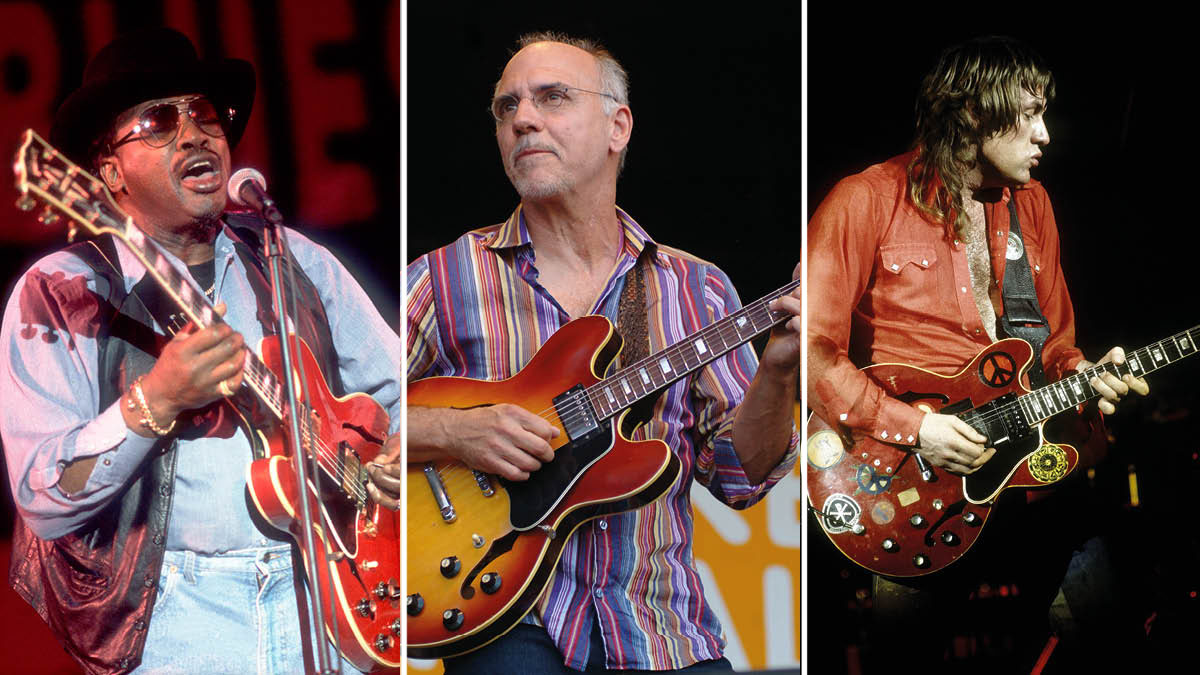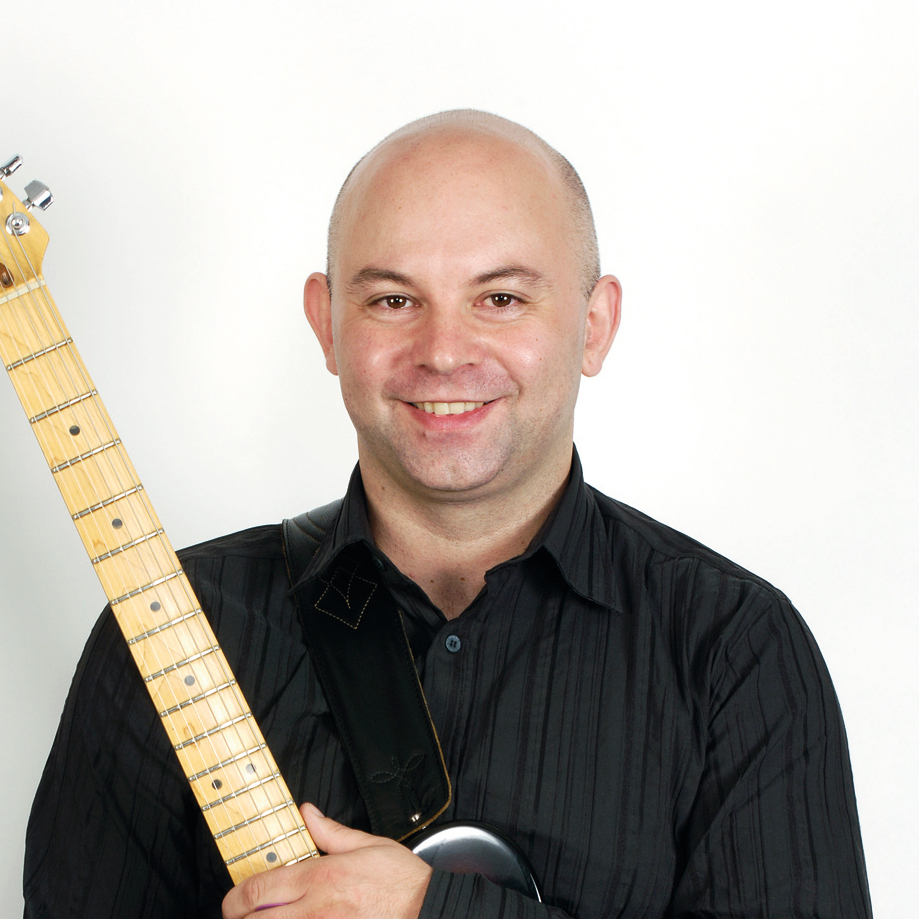Learn the blues styles of 10 iconic Gibson ES-335 guitarists
Lessons in the style of Otis Rush, Larry Carlton, Warren Haynes and more players who helped make the ES-335 the most successful semi-hollow electric guitar of all time

The Gibson ES-335 was initially introduced in 1958. It was designed to combine the aesthetics of a regular arched-top f-hole styled semi-acoustic electric guitar with the volume and sustaining properties of a solidbody.
This came courtesy of Ted McCarty’s inspired decision to include a solid centre block upon which you could mount both the pickups and the bridge, with just the sides left hollow to add a sense of moving air and allowing for greater dynamic range.
Add to this a pair of Seth Lover’s revolutionary humbucking pickups and Gibson produced a match made in heaven.
Needless to say, guitarists from of wide range of contrasting styles were quick to catch onto the sonic potential of these guitars and for over 60 years have made these semi-solid masterpieces a big part of their sound, either choosing Gibson or similar guitars from other guitar brands that were quick to catch on.
Blues legend BB King, rock and roller Chuck Berry, jazz-fusion session supremo Larry Carlton, indie superstar Noel Gallagher and hard rocker Dave Grohl all routinely go the semi-solid route.
The purpose of this article is to explore 10 iconic players that typify what these beautifully versatile, dynamic and expressive instruments have to offer.
The versatility aspect is definitely one of the ES335’s best qualities. Given the premise of our monthly Crossroads feature, exploring the common ground between blues and jazz-based guitar styles and highlighting the similarities along with the nuanced differences between these often intertwined worlds, I generally find my lefty ES-335 is the go-to guitar when it comes to recording the lion’s share of these articles, and I have a lot of guitars to choose from.
Larry Carlton expressed a similar sentiment when asked why he chose this particular model as his main workhorse instrument, with his sunburst ’68 featured on literally hundreds of recordings as both a session musician and a recording and touring artist.
Larry states, "The choice to get a 335 was very practical. I play a lot of different styles of music and I wanted to get a guitar that could cover a lot of bags." Indeed, Larry!
The musical examples that follow are based around a regular 12-bar blues in the key of G, with a shuffle feel at a medium tempo with both a turnaround intro and a four-bar tag ending. The context is a fantasy semi-solid jam session featuring 10 of the best, taking things in turn trading four-bar lines in pairs against an extending backing track.
First up we see Chuck Berry paired with BB King, then onto Alvin Lee jamming with Larry Carlton, before combining Gary Moore with Warren Haynes. Next up we see Eric Johnson paired up with John Scofield, before we bring things to a close with Otis Rush and Eric Clapton-inspired ideas.
As is so often the case, you can choose to learn the entire solo exactly as written or you can perhaps be more selective with your studying, just choosing the licks that immediately stand out and appeal to you (preferably new ones!).
With this in mind, make sure you revisit this article over a period of time, as a phrase, lick or concept that might seem out of reach at the moment might not remain so elusive given some patient and diligent attention to detail and that most precious of commodities, time.
As always enjoy and have fun.
Two Volume Controls
While all the examples presented today feature either the bridge or neck pickup independently, another great option with Gibson-style two volumes and three-way selector switch wiring is to engage both pickups by positioning the toggle in the middle and balancing the ratio between treble (bridge) and bass (neck) with their respective volumes.
The only thing to be wary of is to never reduce either completely to zero, unless you’re after silence as this mutes the guitar completely. However, Pete Townshend utilised this unusual property to great effect by turning the bridge pickup full up, with the neck completely off, switching the toggle rapidly between bridge and middle position to create a form of early ‘kill’ switch.
Special effects aside, the main advantage to this blended volume method is a greater variety of combined tones, rather than the purely 50/50 split you would get with both levels set to maximum (try bridge pickup volume on 10 and neck on 7 for the Crossroads tone).
You can create some interesting sounds by experimenting with the tone controls, too, so put some time aside to really familiarise yourself with how these variables interact and impact upon your tone. Happy exploring.
Fantasy ES-335 All-star Jam
[Bars 1-4] We begin with some classic Chuck Berry double-stop action, neatly following our V7-IV- I7-V7 turnaround (D7-C7-G7-D7), introducing the first of many choruses around a mid-tempo blues shuffle in the key of G.
[Bars 5-8] Our first complete chorus starts with some classic BB King action, mixing elements of both Major and Minor. Consider these ideas more as declamatory statements, rather then more scale-derived melodic material.
[Bars 9-12] Here we’re back to Chuck, with more double-stop vocabulary and a lovely raking sweep-picked idea in bar 11.
[Bars 13-16] Pay close attention to the intonation of your bending technique for the minor 3rd bend in bar 13. Make sure you’re warmed up and let the forearm take the brunt of the heavy lifting, rather than just fingers alone.
[Bars 17-20] Alvin Lee’s rapid and fiery style features lots of repetitious cyclic phrases looped round and round and played at furious speeds. Try isolating
each idea and work with a metronome to get things up to tempo.
[Bars 21-24] For our first Larry Carlton idea we’re mixing both C (C-E-G) and Bb (Bb-D-F) Major triads against our underlying C7 (C-E-G-Bb) harmony to imply C11. The remainder of this phrase is not dissimilar to BB King, in terms of note content and rhythmic phrasing, but the approach remains distinctly Larry’s own..
[Bars 25-28] Some classic rock and roll phrasing from Alvin Lee, again featuring repetition and Alvin’s trademark intensity and fire.
[Bars 29-32] Pay close attention to the pre-bends in bar 29, definitely a Larry Carlton trademark. The trick is to bend the string without sounding it, pick while the bend is in place and then release the string back to its natural state, producing a pitch shift that goes down, rather than up.
[Bars 33-36] Here we see a different kind of repetition and intensity courtesy of Irish blues-rock legend Gary Moore. Again, you might wish to isolate these ideas and work with your metronome to develop speed, accuracy and stamina.
[Bars 37-40] While it’s possible to play the Warren Haynes-inspired one-note-per-string idea in bar 37 purely with the pick, I opted to go for a pick-pick-finger approach, combining a downstroke-downstroke-second-finger hybrid pattern. You could also choose pick-second-third finger or elect to go for the purely fingerstyle route, so make sure you try every option to see what works for you.
[Bars 41-44] We aim for a form of controlled chaos for the bends in bars 43-44, catching both first and second strings at the same time and allowing these notes to ring together to create an exciting and expressive emotive crying bend that evokes the spirit of Albert King but with Gary’s added rock attitude and attack.
[Bars 45-48] This line mixes a repetitive Blues scale idea in G (G-Bb-C-Db-D-F) with a jazzier sounding C Mixolydian idea (C-D-E-F-G-A-Bb) over the harmonically appropriate underlying C7 chord (C-E-G-Bb).
[Bars 49-52] At this point the baton is passed to Eric Johnson and we kick off with some superimposed open triad arpeggios against D7, namely D (D-F#-A), F# Diminished (F#-A-C) and A Minor (A-C-E). Bars 51 and 52 display a little of what Eric has taken from the mighty Jeff Beck, using both open strings and rapid semitone bends and releases.
[Bars 53-56] Pick really close to the bridge if you’d like to get close to John Scofield’s bite and attack. This phrase is derived from the G Blues scale (G-Bb-C-Db-D-F) and makes quite a feature of the b5 note (Db).
[Bars 57-60] You’ll see two types of Pentatonic fives in bars 59-60; first we look at a cross-rhythmic five phrased in triplets in bar 59, and in bar 60 we’ll see five notes crammed into a single beat to create a quintuplet rhythm.
Get The Pick Newsletter
All the latest guitar news, interviews, lessons, reviews, deals and more, direct to your inbox!
John is Head of Guitar at BIMM London and a visiting lecturer for the University of West London (London College of Music) and Chester University. He's performed with artists including Billy Cobham (Miles Davis), John Williams, Frank Gambale (Chick Corea) and Carl Verheyen (Supertramp), and toured the world with John Jorgenson and Carl Palmer.
“There are so many sounds to be discovered when you get away from using a pick”: Jared James Nichols shows you how to add “snap, crackle and pop” to your playing with banjo rolls and string snaps
Don't let chord inversions bamboozle you. It's simply the case of shuffling the notes around









![Joe Bonamassa [left] wears a deep blue suit and polka-dotted shirt and plays his green refin Strat; the late Irish blues legend Rory Gallagher [right] screams and inflicts some punishment on his heavily worn number one Stratocaster.](https://cdn.mos.cms.futurecdn.net/cw28h7UBcTVfTLs7p7eiLe.jpg)


